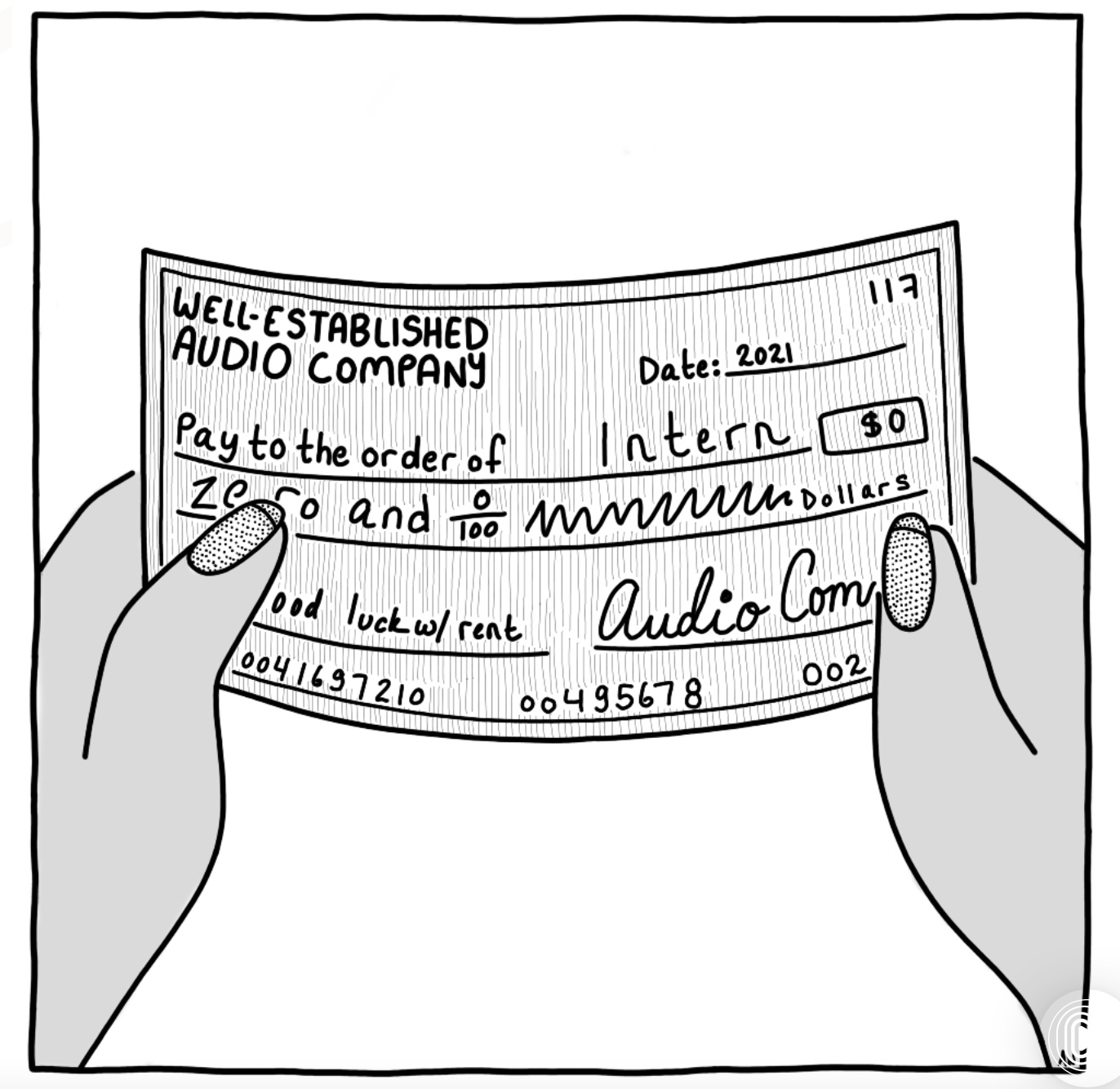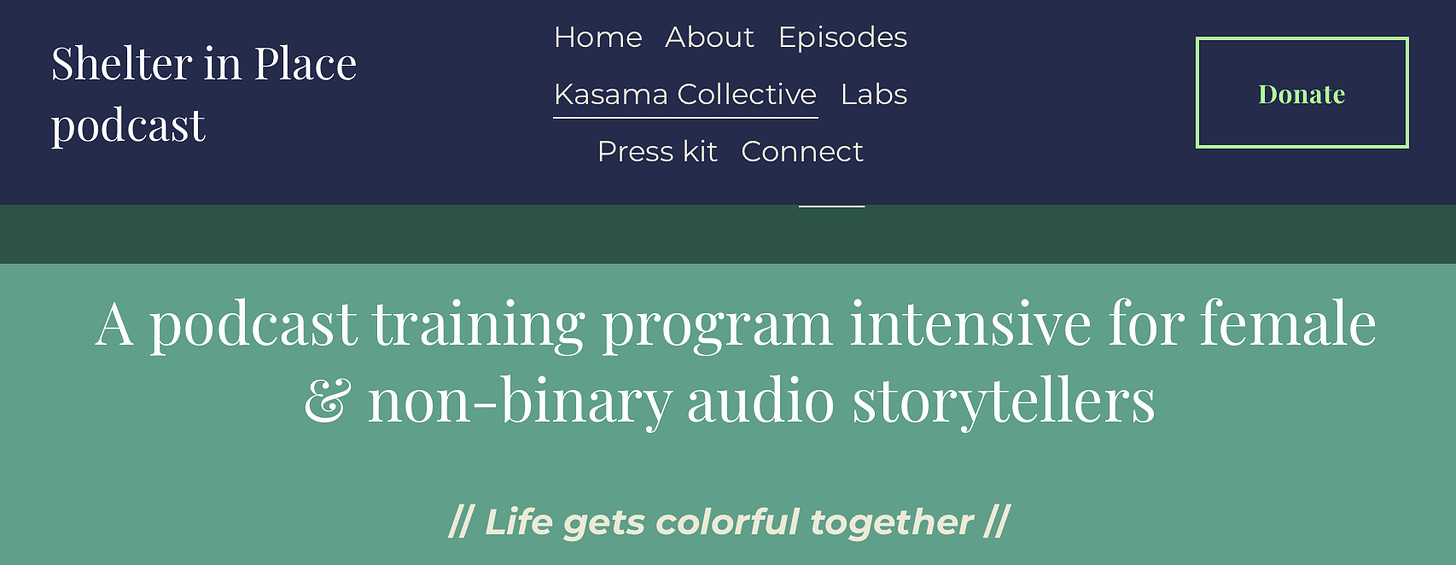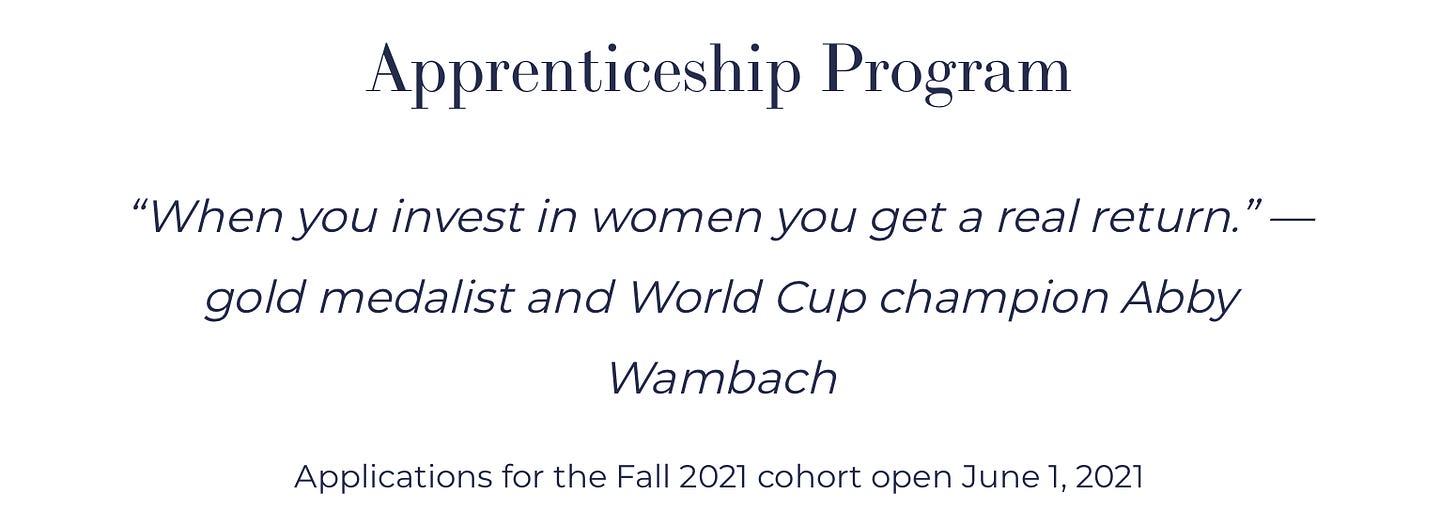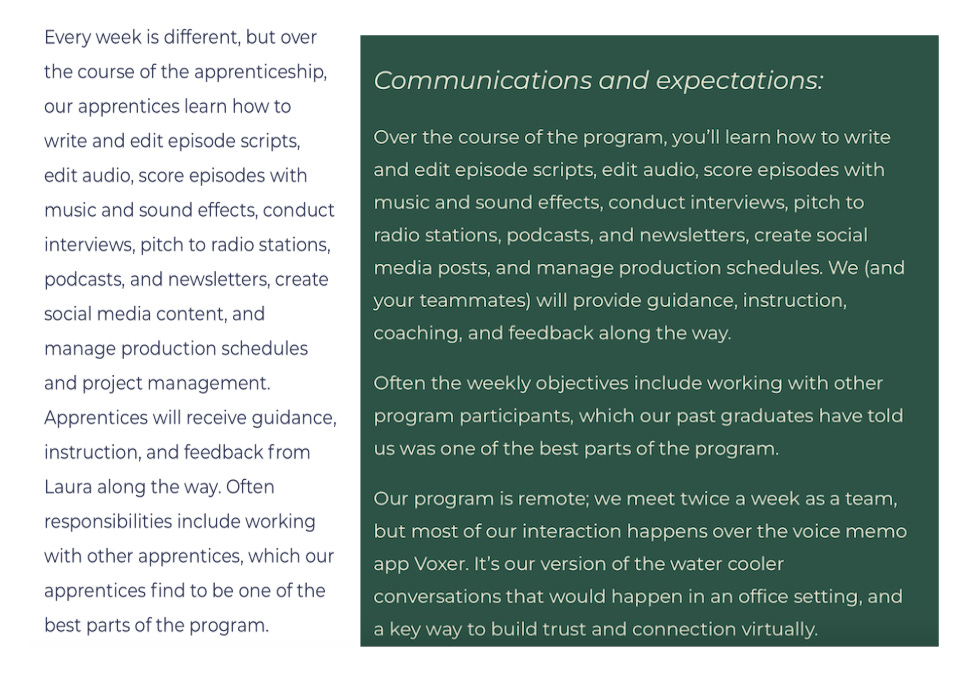Last summer, I wrote a story about audio internships for Nick Quah’s Hot Pod newsletter. As part of my reporting for the piece, I interviewed writer-turned-podcast-host Laura Joyce Davis, whose show Shelter in Place had launched at the start of the pandemic. Described by Laura as “openhearted memoir,” the show chronicled her family’s experience of the Covid-19 lockdown, and eventually explored broader topics such as aging, creativity, and faith.
By the time we spoke, Laura and her husband Nate had been running an unpaid internship to help produce the podcast for a number of months (they preferred the term “apprenticeship”). The program was open to female and non-binary applicants and each seasonal cohort included, on average, four to seven participants.
During our interview, I asked Laura whether she had considered that by definition, her show’s apprenticeship was exclusionary, as it disqualified applicants who couldn’t afford to work for free. (Unpaid internships are also legally dicey, as has been established in court.) In response, she told me that if an applicant couldn’t accept the position without compensation, “I just don't know that they [would] get very much out of it, if they're already feeling so stretched thin in life.”
I couldn’t imagine why someone with less money in the bank wouldn’t get just as much out of an opportunity as anyone else. In fact, I thought it likely that someone with fewer resources might work even harder than their peers, in an effort to improve their circumstances. As I eventually wrote in the piece, my belief was that the baked-in inequity of offering work without pay:
perpetuates the socioeconomic — and ultimately, classist and racist — hierarchies we see at the top of countless companies in this country. Further, when underprivileged groups are denied upward mobility within the media industry, they not only lose the work, but also the chance to bring narratives specific to their experience into public view.

As a courtesy, the night before my story came out, I reached out to Laura to let her know what she could expect to see in print the next day. Here’s an excerpt of that email:
I included a number of really positive things about [apprentice] Melissa's experience at shelter in place in the story, but I also wanted to address certain thorny issues that come up when you offer a program that is unpaid — mostly, the idea that it excludes those who can’t [work] for free.
When Laura emailed me back the next morning, it appeared that her perspective on the subject of unpaid work had evolved. She wrote:
Something I have been thinking about since our conversation is a model I'd like us to move toward: working with outside companies to fund apprentices to complete our training…thank you for prompting me to think more deeply about this and reach out to some people who can help us think through how we might get there. We care a lot about inclusion, and I wish we were in a position to address this immediately!
A few months later, I discovered that the Davises had indeed changed the program, but not in the way I had anticipated. Instead of “working with outside companies to fund apprentices,” the Davises had rebranded their program as a $4,000 dollar training now called the Kasama Collective. (They had also launched a self-paced training course called Kasama Labs, eventually renamed “Labs Weekender.”) According to the Shelter in Place website, the Davises had chosen the word “Kasama,” which means “together” in Filipino, as a “tribute to the culture and people of the Philippines,” where the couple had lived for one year.
Shortly after learning this news, I began reaching out to Laura, asking if we could hop on the phone so she could explain the difference between the Kasama Collective and the original apprenticeship. Surely fundamental changes had been made to the program’s curriculum, if the Davises were now charging thousands of dollars for people to take part in it — right? On most occasions, Laura replied that she was too busy to talk, other times she pointed me to episodes of her show, said she was sick, or ignored my inquiries altogether. Recently, she was more blunt, stating “I'm not interested in having an on the record conversation with you.”
With help from the wayback machine, I began sifting through Shelter in Place’s language regarding the apprenticeship and comparing it with descriptions of the Kasama Collective on the podcast’s newly revamped website. In doing this work, I wasn’t able to find any evidence that the program itself had changed; indeed, the only difference seemed to be its new (and some might say, culturally appropriated) moniker and its $4,000 price tag (according to the website, “scholarships are available” but as far as I can tell, none have been granted).
To help illustrate the similarities, I’ve included a side-by-side comparison of language from the old and new websites below. On the left is text describing how “a typical week” of the apprenticeship was described in 2021 and on the right you’ll find language that describes “a typical week” at the Kasama Collective today.
Just as these passages are fundamentally the same, so are all the rest — even down to specific details of each program. For example, the amount of time set aside for discussing professional goals and other mentorship-related topics (what the Davises call “module meetings”) is 90 minutes per week in both programs, amounting to 15% of the total time required by participants.
In an effort to reality-check what I was seeing, I reached out to Alice Wilder who, in partnership with the training organization Transom, writes Starting Out, a newsletter for people entering the world of audio (it’s excellent!). In service to her readers, Wilder spends hours combing through postings for internships, fellowships and apprenticeship programs, and yet she told me that she’d “never seen one that charged the participant money to work on someone else's podcast.” (A spokesperson for audio training and resource organization AIR told me the same thing.)
“That’s just wild,” Wilder said. “I would never recommend someone take a job like this; it’s exploitation.”
While it is indeed wild, Wilder also acknowledged that options for eager would-be audiomakers are limited and extremely competitive. The most popular programs for entry level applicants in audio can attract many hundreds of resumes, giving even the most confident of applicants pause.

Many training programs are just as impacted; former lead instructor for Transom’s acclaimed Story Workshop program Rob Rosenthal told me that his trainings always “had more applicants than we knew what to do with. We were through the roof and could never meet demand.”
According to Wilder, there are plenty of people eager to break into audio “who are just at the end of their rope. They’ve gotten degrees in journalism or audio production and are still having trouble getting jobs. They desperately want to get their foot in the door of this industry and feel like they're up against a brick wall.”
Given all this, it’s easy to have empathy for those who agree to pay $4,000 for something they can add to their resume. Last year, it also helped me make sense of the fact that the Shelter in Place apprentices I interviewed, despite expressing some misgivings over its unpaid status, said they were genuinely grateful for the program.
Over the course of the past year, the Davises have leaned into this dynamic, publishing print and audio testimonials from participants in their programs on the show’s website and including tape of their positive words in multiple episodes of Shelter in Place.
However, in my view, these endorsements reflect the indisputable power imbalance at play. When Laura agonizes —during a recorded session for an episode of her show — over whether she should reinvent her apprenticeship as a training, of course her apprentices lend support to the idea. When Laura asks them to say good things about the Kasama Collective, of course they do it willingly. After all, they are truly grateful and willing to put their gratefulness on tape. But do they really have a choice?
And with those glowing testimonials in place, the Davises can point to them as justification for the program’s very existence and proof that at the end of the day, the model works — everyone’s happy! Everyone’s grateful!
In last year’s story for Hot Pod, I admitted to a certain amount of discomfort in comparing Shelter in Place’s apprentice program with those offered by organizations with more resources (NPR, Pineapple Street Studios, and Dustlight Productions were also featured in the piece). Ultimately though, my decision to publish came down to this:
If the audio community is committed to rectifying inequalities within its ranks, I would argue that that commitment should come from everyone who is in a position to bring new people into the industry.
Which is also to say, if you can’t afford to make your show without taking financial advantage of the people who help produce it, perhaps you shouldn’t have a show at all.
That’s it for me this week!
See you next Thursday.
Skye
P.S. If you aren’t listening to Shameless Acquisition Target, what are you even doing?








Kudos Zuri. I had a very similar situation happening to me at the start of my career. Since then, I took a vow to never take advantage of people, have any sort of paid internship, and exploit people trying to get into an industry where "fulfilling a passion" can be a substitute to free labor.
A little while ago I was accepted onto a 'Fellowship' that turned out to be a very expensive online class, to the tune of $2000. Even on low income etc they'd only give me 50% off, which I could absolutely not afford. When I challenged that the word 'Fellowship' usually denotes a spot at an academic institution that is in fact paid, and not paid for, they said nothing. This was with some kind of Silicon Valley start-up, marketing itself as a virtual Stanford alumni association but without any academic legitimacy. I'm sure it'll provide useful insights and a great networking opportunity, which is why I applied, but to turn around and ask people who are trying to get a foot in the industry to pay thousands for some masterclass type advice and an off brand LinkedIn website..... 🙄🙄🙄